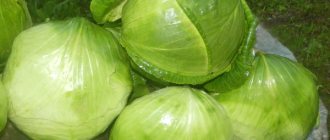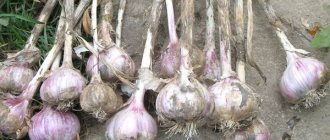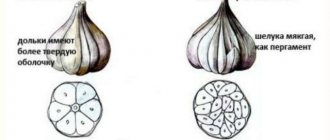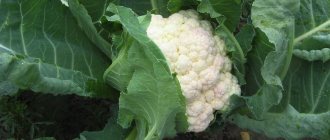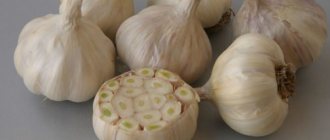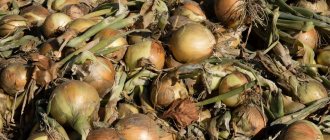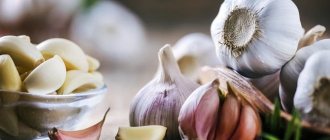Most summer residents prefer to plant winter garlic before winter, and spring garlic in early spring. When to remove garlic from the garden? When should I dig it up for storage? How to determine the timing of garlic harvesting? Let's look into it in more detail. After all, this healthy and piquant-tasting vegetable can be found in almost every garden. It is extremely undesirable to keep garlic in the ground: it may begin to grow again, overripe heads will disintegrate into individual cloves, and long-term storage of such a crop will be a big question. If you remove garlic from the soil ahead of time, it will be soft, unripe and loose. The keeping quality of this vegetable directly depends on the degree of its ripening and proper drying, so you should remember a few simple rules, which I will tell you about in this article.
Drying garlic (photo by Anna Nepetrovskaya from Novokubansk)
Determining whether garlic is fully ripe
They begin to harvest garlic from the end of July, until about the beginning of August (we are talking about winter species). Before harvesting, the gardener must ensure that the garlic is ripe and ready for digging and storing. This guarantees not only the good taste of future dishes, but also the shelf life of the product (i.e., the duration of its storage in the best possible way while maintaining all the beneficial properties and appearance). It is especially important not to miss ripening if the crop is grown on a large scale for further sale.
How do you know that the crop is ripe and it’s time to dig up garlic from the garden? It is necessary to carefully monitor changes in the appearance of the plant, both its above-ground part and the bulbs. Ripening is signaled by:
- Air sacs or inflorescences . On the arrows stretching upward, the outer shells of the inflorescences burst, and seeds or, as they are called, bulbs begin to appear.
- Leaves. The lower shoots of the plant look drier and turn yellow, the upper ones also acquire a yellow tint. If most of the leaves look like this, it means the plant has stopped photosynthesizing and growing. It's time to harvest. When the leaves withered and lay on the ground, it means they were late with the cleaning.
- Bulbs. For testing, pull out a couple of heads or dig them halfway, preferably on different sides of the bed. Mature specimens should be dense, easily separated from each other, and covered with two or more scaly layers that are easily removed. The scales have a purple tint. The teeth of the unripe winter variety are soft, while the teeth of the overripe variety are cracked.
Often, summer residents prune the bolting variety during the growth period, depriving themselves of the opportunity to determine ripening by the rods. But experienced gardeners recommend not cutting off at least a few rods in order to then determine the degree of maturity of the entire crop from them. In addition, the bulbs will then be planted, and each of them will sprout.
How to judge maturity by appearance
The first sign of garlic maturity is the drying of the lower tier of leaves. To get a more detailed picture, you need to dig up several bushes from different parts of the bed (along the edges and from the middle). The appearance of the plant head is the best criterion for assessing the degree of maturity and readiness of the crop for harvesting, this is:
- large juicy cloves with dense scales;
- dried out covering on the bulb.
To successfully store the crop, you should not overexpose the garlic in the garden. The shell becomes thinner and the head crumbles into individual cloves. This garlic is only suitable for processing or planting in the ground, but not for storage.
A plant that is not mature enough for harvesting has soft scales and succulent integumentary membranes. When dried and stored, it quickly withers and is not stored for long - half the allotted time.
For daily consumption, for seaming and pickling cucumbers/tomatoes, the plant is taken from the garden, regardless of the degree of ripeness. Only ripe and well-dried garlic is suitable for winter storage.
In the video, the author shows what garlic bulbs that can be collected from the garden should look like.
Collection times depending on regions
As a rule, gardeners in Russia harvest garlic in mid-summer. Early ripening varieties are ready 10-14 days earlier than late ripening varieties. But climate features, depending on the regions where the crop is planted, make their own adjustments. Ripening is affected by the early or late onset of spring, whether the summer months are hot or humid. The usual assembly time may shift by a week or longer in one direction or another due to weather conditions.
The growing season is shortened if the summer is rainy. Heat and dryness inhibit ripening.
Approximate cleaning times depending on the region are as follows:
- In Crimea, the Caucasus region and other southern regions, the dacha season begins early. Winter garlic varieties fully ripen by July 5-10.
- In Central Russia - the Chernozem region, the Volga region - the first harvest is dug up from July 10 and later. In the Moscow region a little later: from July 12 until the end of the month.
- In Siberia and the Far East, winter varieties ripen in the last ten days of July, and if the summer is cool, the harvest is harvested in early August.
- Towards the beginning of August, garlic is harvested in the northern regions.
What to do with garlic after harvesting
Dried garlic is sorted. Small bulbs and heads with mechanical damage are allowed for processing. Only completely healthy root crops with a well-dried neck are selected for storage. Vegetables that are moldy, rotten, or with traces of pest activity are thrown away.
Mid-season and late varieties are more suitable for long-term storage; early winter garlic is used first.
The tops are cut depending on the storage method. If the garlic is hung braided, most of the stem is left. When storing vegetables tied in bunches, trimming is done at a distance of 20-25 cm from the head. The roots are shortened, leaving 3-5 mm. The remaining ends are lightly scorched over the fire.
Optimal storage conditions for garlic: a dark place with moderate humidity and temperature. Garlic will not be stored for long in a damp room; if there is a lack of moisture in the air, it dries out quickly. The optimal temperature for good keeping quality of winter garlic is +5-18˚С, for spring garlic - +15-20˚С. When stored in a warm place, the vegetable quickly begins to germinate, but at low temperatures it loses its taste.
During storage, garlic is periodically sorted, discarding dried, moldy and rotten bulbs.
To provide yourself with garlic for the whole winter, it is not enough to grow a crop. Correctly determining the maturity of a vegetable, competently carrying out activities for harvesting and preparing garlic for storage is a guarantee that the work will not be in vain and the vegetable will be well preserved. Harvesting of ripe garlic is carried out in clear weather without precipitation, on days that are favorable according to the gardener’s lunar calendar.
Features of collection according to the lunar calendar
Some gardeners harvest garlic by checking the lunar calendar, as it is believed that digging up the heads on certain days will extend their shelf life. Focusing on the movement of the Moon, all the necessary manipulations are carried out: hilling, trimming arrows, loosening, etc.
Harvesting during the waning moon. When the garlic is technically ripe, they begin to dig it up at any convenient time, excluding the days of the full moon and new moon.
According to the lunar calendar of 2022, favorable periods for harvesting winter varieties:
- from July 18 to July 31;
- from 16 to 29 August.
Once clear signs of ripeness have appeared, the crop must be harvested within one week. If you do this earlier, the garlic will be loose, and overripe heads may begin to grow again and will be stored worse. Due to inexperience, summer residents will receive a product of reduced quality.
We clean it correctly - we store it for a long time
After checking the “control” roots, it became clear that the garlic was ripe. The rules for cleaning for storage are very logical and simple:
- In dry weather, dig up the garlic in the morning. It's better to do this with a pitchfork. Under no circumstances should garlic be pulled out by the tops - breaking the roots and damaging the bottom can lead to rotting of the bulb.
- Spread out in a thin layer so that the soil remaining on the roots dries and crumbles. Do not knock the soil from the roots - this leads to damage to the bulb and loss of shelf life.
- Shake off the soil from the roots and transfer it to dry in a dry place with good ventilation: a barn, shed, etc.
- It is most convenient to hang dry the garlic by tying the garlic in bunches of about 10-15 plants. This drying method provides excellent ventilation and additional flow of nutrients to the bulb.
- Dried leaves are a sign that the garlic is completely ready for storage.
- The roots and dried stem are trimmed with pruning shears.
- The garlic is dried in mesh boxes or spread out in a thin layer for another 1-2 weeks.
Garlic harvested in due time is perfectly stored: winter until January, and spring until early summer. Spring garlic with its soft pliable stems is woven into braids, winter garlic is knitted into bundles. This is not only a storage method - an element of folk style brings coziness to the design of an urban kitchen.
When and how to harvest winter garlic?
The harvesting scheme for winter and summer varieties of garlic (that is, winter and spring varieties) is the same. The harvest is harvested in clear and dry weather, early in the morning or late in the evening, when the summer heat has subsided. The collection procedure is as follows:
- The heads are dug up with a shovel, a pitchfork or a special device - a garden fork. Carefully remove them from the ground, without tugging, so as not to damage the fragile roots.
- Remove any stuck soil from the roots. Do not beat them off and shake them off, otherwise the teeth will be damaged and rot.
- The dug up garlic plants are placed in rows along the beds so that they dry out.
- It is advisable to eat damaged heads immediately and not leave them for long-term storage. If they are rotten or moldy, throw them away.
A specialist will tell you how to check the maturity of garlic and correctly remove the heads from the ground. Watch the video:
What weather should you dig in and how to dry?
Harvesting is carried out on sunny, dry days; it is better to have several days without rain before harvesting. Collection is usually done by hand; the heads are carefully dug up with a shovel or pitchfork, trying not to damage them.
Attention! It is not recommended to dig up garlic from the garden for storage in rainy weather. If there are prolonged rains and there is no other way out, you need to harvest the crop before it rots, dry the heads thoroughly, then clear the soil.
After harvesting, preparations for storage are carried out:
- The heads should first be dried in a well-ventilated, bright place.
- Subsequent drying is carried out in a room, in a place without access to sunlight.
- Then you need to shorten the ends of the leaves and trim the roots. If you plan to weave braids, the stems are left longer.
- Thoroughly clean the heads with a gloved hand, getting rid of any dirt and possible soil residues.
Preparation and storage
After the winter garlic is dug out from the garden without removing the roots and leaves, the cloves are dried for a week or a little longer (from 7 to 10 days). Some leave the crop directly in the garden, but this can only be done in dry weather. It is important to consider that dew falls at night, soaking the collected fagots. While the garlic dries, all the nutrients from the tops move into the bulbs.
Typically, garlic is dried in a room protected from rain: on a summer veranda, under a canopy, in a barn or attic. The selected location must have good ventilation. The bulbs are laid out on a wooden table or on the floor - on a newspaper. It is not necessary to pre-wash them, although some do.
After 1-2 weeks, the resting cloves are subjected to such manipulations as trimming roots, tops and leaves. This is done with a special pruning shears so as not to damage the mature bulbs. When stored in a warm room, especially in a city apartment, improperly trimmed cloves may germinate. The roots are cut as follows:
- If garlic plants are sold, a minimum beard of 1-3 mm is left on their bottom or the roots are cut off completely, leaving a depression.
- Otherwise, it is allowed to cut off the roots, leaving about 3-5 mm in length. This garlic stores well.
- When it is planned to use part of the crop for further planting, the acceptable root size is 5-10 mm.
An effective, albeit time-consuming way to protect teeth from sprouting: seal the roots and bottom with hot wax. Such garlic plants are not suitable for further planting, but they have good shelf life and will overwinter well even in less than ideal conditions.
How to properly harvest garlic for further storage?
Cleaning plants requires special attention. If it is done carelessly and not according to the rules, you can quickly lose the entire harvest.
Basic harvesting rules that will help preserve grown garlic:
- It is more convenient to dig up garlic with a pitchfork rather than a shovel. It is better to use a small but well-sharpened tool. You need to stick it into the ground at a distance of 5-10 cm from the intended location of the bulb.
- Do not pull or pull leaves. Such exposure leads to invisible damage to the integrity of the planted garlic, which will contribute to its rapid deterioration.
- The roots must be carefully but gently shaken off earthen clods. If you have difficulty, it is better to leave the soil on them than to tear them off.
- The dug up garlic should be spread in one layer on an earthen dump to dry. You can turn it regularly to allow light and air to reach the garlic.
- It is advisable to remove dried garlic indoors before evening so that fallen dew does not have time to wet it.
Following simple rules will be a definite guarantee that the teeth will remain throughout the winter and will not lose their taste and medicinal properties.
Should the arrows be removed?
Before long-term storage, dry garlic shoots - shoots that have grown upwards - are removed. The optimal cut length of the neck: 6-10 cm, it depends on what form of storage is chosen:
- If you plan to store the crop in bunches, the cuttings are left 10 to 15 cm long. This makes it easier to tie several heads together.
- A short stem no more than 3 cm is convenient when the crop is placed in a hanging net, box or box. But the cover scale should be below the cut line, which will help avoid rot.
- The ancient method of storing garlic in braids involves the presence of almost the entire stem - both the arrow and the leaves.
After processing each head, all harvested garlic is ready for long-term storage. Before storing, it is recommended to sort the heads by size and take care of the cleanliness of the selected containers: sterilize the glass containers, sprinkle the bags with table salt (if you plan to keep the crop in a damp room - a cellar or basement), etc.
Small garlic cloves are often filled with oil and stored in the refrigerator. This garlic is convenient to use for dressing salads.
An experienced gardener will demonstrate how to tie a braid of garlic. See more details in the video:
Having taken care of the proper collection and storage of garlic, the entire harvest will be put to use without leaving a trace - sent for sale, used for preparing fresh dishes or canning. Harvesting garlic is not difficult; even novice gardeners who are doing this for the first time will not suffer losses.
0
0
Copy link
Harvest timing - why is it important?
It is very risky to wait until the bulbs reach their maximum size. After this, the evolutionary process begins without delay - the outer scales become thinner, the head breaks up into individual cloves. This garlic can be used in the kitchen; it cannot be stored.
The gardener faces a difficult task - to determine the very moment when “tomorrow will be too late.” General recommendations will not help you find this fine line, since the timing of garlic’s readiness for harvesting depends on many factors:
- varieties - winter or spring;
- belonging to the group of early, mid-season, late varieties;
- region of growth.
One-year-old garlic grown from “airs” or “bulbs” is not always chosen for the winter - there are three-year cycles of growing full heads without annual sampling and planting in the ground.
The main problem: it is difficult, looking at the garden bed, to assess the condition of the bulbs with one inspection. You can dig up several bushes every day if there is a large area of plantings. On a typical summer cottage plot of 6 acres, the garden bed occupies an area of several square meters.
To select the right moment, it is advisable to use other methods based on the experience and knowledge of professional agronomists.
How to Preserve Garlic Heads for the Winter
A feature of winter garlic is that it, in principle, is stored for a shorter period than spring garlic due to the fact that it has fewer covering scales. Therefore, storage conditions play a big role. Winter garlic may dry out due to loss of moisture.
If the storage is warm and the air is humid, the vegetable can become moldy or rot. In any case, even under very good conditions, winter garlic retains all its qualities until the New Year, after which the heads begin to sprout and signs of deterioration appear on them.
Storage conditions
The most suitable premises for storing harvested vegetables, including garlic, are considered to be a cellar and basement. Before planting the crop there, thorough cleaning is carried out. If necessary, insects and rodents are removed from the storage facility by setting traps and laying out bait. This must be done in advance. At the same time, they check the operation of the ventilation and also carry out treatment with antiseptic and antifungal drugs.
If there are no utility rooms available, you can store garlic in the apartment, on an insulated balcony, or in the refrigerator.
The vegetable is best preserved at a temperature of 2-4 °C. At higher values, the cloves will begin to sprout, and at minus levels the heads will freeze.
It is advisable not to allow significant temperature fluctuations - this can cause garlic to lose its beneficial properties and taste.
The air humidity should be 50-80%. In a room that is too dry, the garlic will dry out, and in a damp basement it can rot or become moldy. The harvest should not be stored in the light. If the garlic is kept in a room with natural light, it should not be exposed to direct sunlight. It is important that air exchange occurs regularly in the storage facility.
Methods for storing garlic
In whatever way summer residents store their garlic harvest. Everyone chooses the storage option that is more convenient for them. And there is plenty to choose from.
There are various ways to store garlic:
In braids
For this storage method, the stem and leaves are not trimmed. This method was used by ancient villagers and is still used today. The tops of the vegetable are braided together with twine or rope.
The advantage of the method is the compactness of the braids; they can easily be hung in storage without taking up additional space, which is useful for installing boxes with other vegetables.
Bunches
To store this method, the stems are not intertwined, but simply tied. It is better to form stepped bundles, where every few heads are tied slightly higher than the previous ones. With this storage, the garlic is well ventilated and does not spoil.
In grids
First you will have to stock up on nylon nets for vegetables or exotic fruits. For example, they sell pomelo. The method again does not require much storage space. Garlic nets are easy to hang in any convenient place. A vegetable stored in this way will definitely not rot, but it may begin to dry out or sprout. The heads will need to be rebuilt periodically. You can replace the nets with nylon stockings.
In wicker baskets
This method is good because, thanks to the loose weave of the basket walls, the garlic is well ventilated, which means it spoils less. Some people store vegetables this way right in the room, but you need to remember that winter garlic needs coolness for storage. But spring garlic can easily last for several months at a temperature of about 20 °C.
In boxes of salt
You can make the box yourself from ordinary plywood. A layer of salt is poured onto the bottom, on top of which the garlic heads are placed so that they do not touch each other. Then the layers are repeated. This method is especially good in damp rooms. Salt is an adsorbent and perfectly absorbs excess moisture from the air, ensuring good preservation of garlic.
In flour
In this way, garlic is preserved well and for a long time even in an apartment. 3-liter jars are used as containers. Place a thick layer of flour on the bottom, and then place the garlic bulbs in the jar, sprinkling them with flour until the entire jar is filled. Wood ash can be used instead of flour if available.
In glass jars
Despite its simplicity, this storage method shows excellent results. For reliability, it is advisable to sterilize the jars. Such containers will equally protect the garlic from excessive dryness and mold.
In onion skins
When using this method, garlic is stored well even on a cabinet shelf or on the mezzanine. You will need to first save up more onion skins. Garlic heads are placed in a cardboard box or box, generously sprinkled with husks, which have bactericidal properties and maintain moisture balance, which ensures a long shelf life.
Storage in bags
Experienced summer residents who know how to collect and store garlic will tell you about many methods of proper storage, each of which has certain advantages.
One of the most convenient storage methods is in bags. Different types of bags are suitable here - both linen and mesh. The main thing is not to use garbage bags, construction or otherwise, made from moisture-proof materials. Otherwise, the moisture evaporating from the cloves will accumulate inside the bag, which will lead to the rapid development of fungi, mold and rot.
In addition, it is advisable to conduct an inspection at least once a month. This takes little time - just pour the garlic onto the floor, carefully examine it, and remove the rotten heads. If you do not do this, the shelf life of a valuable product will be significantly reduced.


